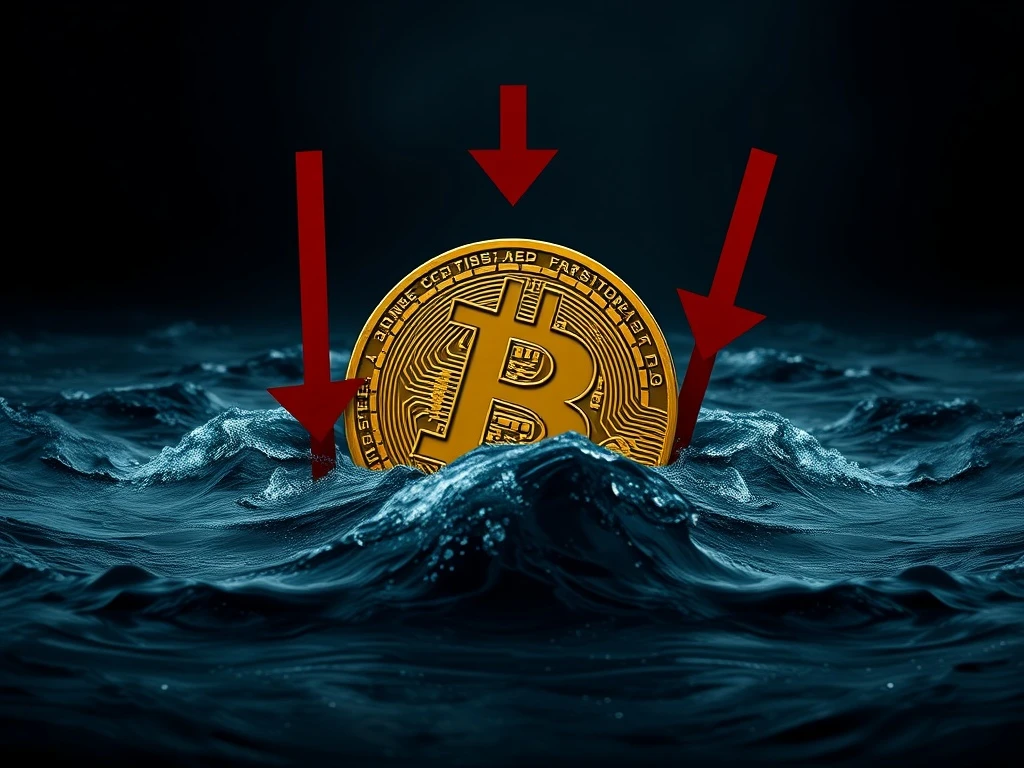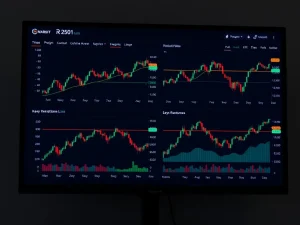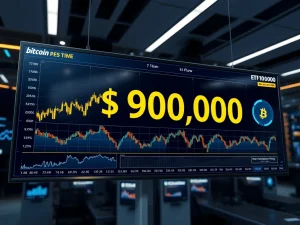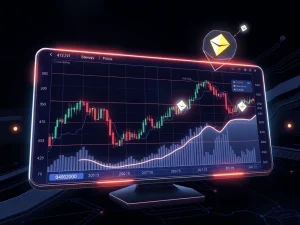Urgent Bitcoin Futures Warning: Bearish Sentiment Deepens Below -$100 Million

The cryptocurrency market is buzzing with a palpable sense of apprehension as recent data on Bitcoin futures reveals a concerning shift in trader sentiment. What was once a subtle undercurrent of caution has intensified into a strong bearish signal, leaving many wondering: what’s next for Bitcoin?
Decoding the Plunge: What Does the Bitcoin Futures Net Position Tell Us?
The derivatives market, often a bellwether for future price movements, is currently painting a stark picture. The Bitcoin futures net position, a crucial metric reflecting the aggregate difference between long (buy) and short (sell) contracts, has plummeted below -$100 million. This marks the lowest level of speculative activity observed since early July, indicating a significant imbalance in betting behavior.
This deep-negative figure is a strong indicator of intensifying bearish sentiment. It means that short positions—bets on falling prices—are overwhelmingly dominating over long positions. Analysts interpret this as an aggressive expectation among traders for further price declines. Furthermore, the overall decline in open interest (OI) suggests not just a shift in bias, but also reduced speculative activity. This combination creates a scenario where market participants are increasingly inclined to profit from downward price movements, signaling heightened selling pressure.
Bitcoin Price Resilience: A Temporary Shield Against Bearish Waves?
Despite the dire signals emanating from the derivatives market, Bitcoin’s spot price has demonstrated a surprising degree of resilience, holding steady near $115,000. This stability suggests that buyers in the cash market are, for now, partially offsetting the aggressive selling pressure observed in futures contracts. This divergence between spot price stability and bearish derivatives activity underscores a fragile equilibrium in the market.
However, the persistence of deep-negative open interest highlights ongoing pessimism among traders, who continue to position for further declines. The market is closely monitoring whether spot buyers can sustain this price level amid heightened short-term risk. This dynamic also raises the possibility of a short squeeze—a scenario where a sudden price rebound forces short sellers to cover their positions, triggering a cascade of buying that could create temporary upward momentum. Yet, the likelihood of such an event hinges on a significant reduction in bearish open interest or a substantial surge in buying volume from the spot market.
Ripple Effects Across the Crypto Market: Altcoins Under Pressure
The negative sentiment isn’t confined to Bitcoin’s futures market alone; it has sent ripples across the entire crypto market. The overall cryptocurrency market capitalization has experienced a notable 6% decline, reflecting widespread selling pressure across the sector. Both Bitcoin and Ethereum (ETH), the two largest cryptocurrencies, have entered negative territory, contributing to the broader market weakness.
This weakness has been particularly exacerbated in major altcoins, which have seen sharper declines compared to Bitcoin’s relatively stable performance. For instance, Shiba Inu (SHIB) experienced a significant 12% drop after failing to break key resistance levels, amplifying concerns about broader market fragility. This disparity underscores Bitcoin’s enduring role as a barometer for overall market sentiment, with its bearish trajectory influencing smaller cryptocurrencies disproportionately and often leading to more pronounced downturns for altcoins.
Macroeconomic Tides and the Path Forward for Bitcoin
Adding another layer of complexity, macroeconomic factors have introduced additional uncertainty into the crypto landscape. Speculation around potential U.S. interest rate cuts, following signals from figures like Donald Trump and Federal Reserve Chair Jerome Powell, has sparked debates about their potential impact on risk-on assets like Bitcoin. While the direct link between rate-cut expectations and Bitcoin’s recent performance remains unclear, the broader macroeconomic environment continues to shape investor caution and risk appetite.
The interplay between declining open interest in futures and the relative stability of Bitcoin’s spot price has left the market at a critical crossroads. Historical patterns suggest that sharp declines in derivatives activity can often precede significant corrections, but they can also indicate oversold conditions that eventually attract new buyers. Traders are now weighing the risks of further bearish consolidation against the possibility of a rebound driven by renewed bullish conviction. Analysts emphasize that any sustained recovery will likely depend on renewed institutional participation and greater macroeconomic clarity, as current conditions continue to favor downside risks.
Conclusion: Navigating the Crossroads
The current state of the Bitcoin market is a delicate balancing act. While the intensifying bearish sentiment in the futures market signals strong expectations for lower prices, Bitcoin’s spot price has shown a surprising resilience, holding a key support level. This divergence creates a period of heightened uncertainty, where the potential for further declines clashes with the possibility of a short-term rebound.
For traders and investors, vigilance is key. The path forward for Bitcoin will largely depend on whether spot buyers can continue to absorb selling pressure, or if the overwhelming bearish sentiment in derivatives will eventually force a significant price correction. Watching for a substantial reduction in negative open interest or a clear surge in buying volume will be crucial signals for any potential shift in this fragile equilibrium.
Frequently Asked Questions (FAQs)
1. What does a negative Bitcoin futures net position indicate?
A negative Bitcoin futures net position indicates that the aggregate number of short contracts (bets on price decline) significantly outweighs the number of long contracts (bets on price increase). This signals a dominant bearish sentiment among traders, who are actively positioning for lower prices.
2. Why is Bitcoin’s spot price remaining stable despite bearish futures data?
The stability in Bitcoin’s spot price, despite bearish futures data, suggests a divergence where buyers in the cash market are currently strong enough to absorb the selling pressure from the derivatives market. This creates a fragile equilibrium, but it doesn’t negate the underlying bearish sentiment from futures traders.
3. What is a “short squeeze” and could it happen to Bitcoin?
A short squeeze is a market phenomenon where a rapid increase in an asset’s price forces short sellers (who bet on price declines) to buy back the asset to limit their losses. This sudden buying pressure can further propel the price upwards. While possible for Bitcoin, it would likely require a significant reduction in bearish open interest or a substantial influx of buying volume to trigger such an event.
4. How are altcoins performing compared to Bitcoin during this period?
During periods of intensifying bearish sentiment, altcoins often experience sharper declines than Bitcoin. Bitcoin tends to act as a barometer for the overall crypto market, and its weakness can disproportionately impact smaller cryptocurrencies, leading to more significant percentage drops for altcoins like Shiba Inu (SHIB) and others.
5. What role do macroeconomic factors play in current Bitcoin sentiment?
Macroeconomic factors, such as speculation around interest rate cuts or broader economic uncertainty, can significantly influence investor caution and appetite for risk-on assets like Bitcoin. While the direct correlation isn’t always immediate, the overall economic environment plays a crucial role in shaping market sentiment and investment decisions in the cryptocurrency space.
6. What should traders watch for to signal a market reversal?
Traders should closely monitor the Bitcoin futures net position and overall open interest. A significant reduction in the deep-negative open interest, indicating a decrease in bearish positioning, or a clear and sustained surge in buying volume in the spot market would be key signals that could indicate a potential market reversal or a shift away from the current bearish trend.










